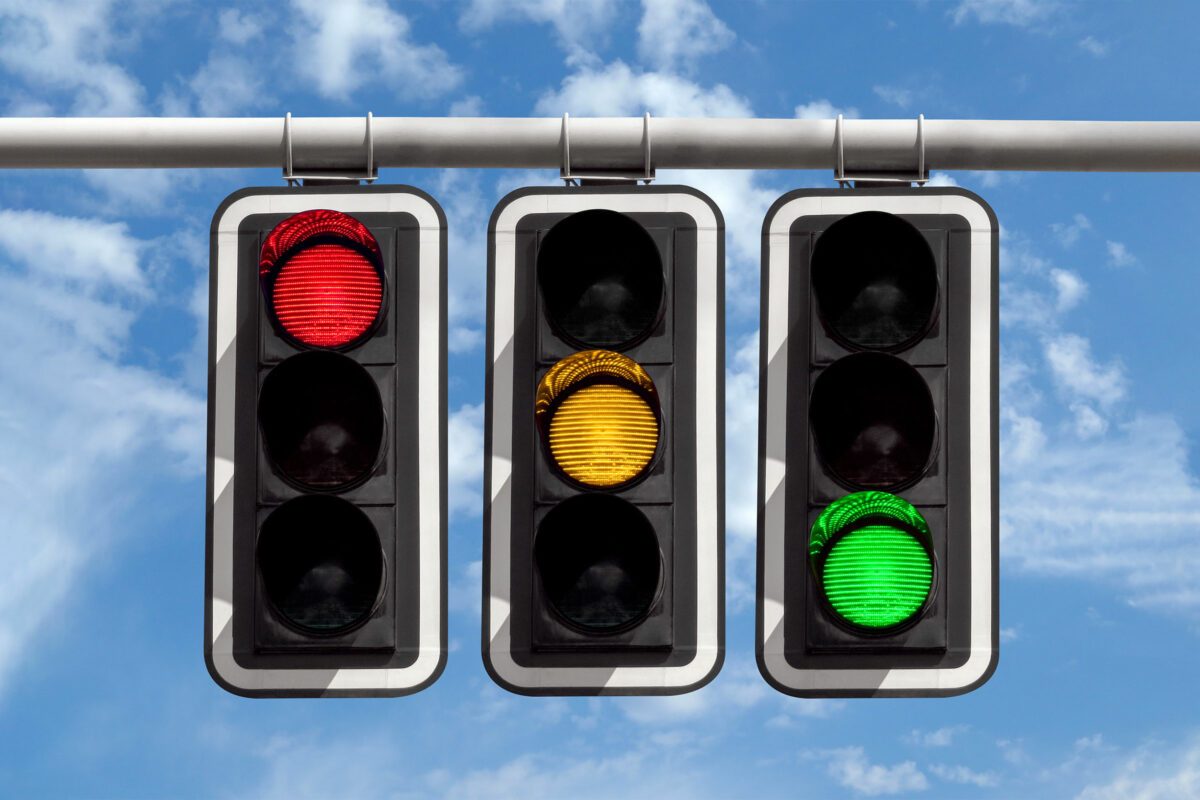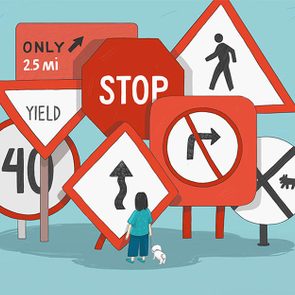There's a perfectly good explanation for those familiar traffic light colors

This Is Why Traffic Light Colors Are Red, Yellow and Green

When you hop in your car to head to work, drop your kids off at school or make a Target run, how many traffic lights do you encounter? Unless you live in a one-stoplight town, it’s probably more than a few. And even though the news is filled with car, bike and pedestrian crashes, those traffic lights you pass under or come to a stop in front of keep traffic flowing relatively seamlessly, especially compared with the days before traffic signals.
Things looked different at the turn of the 20th century, when busy cities like New York, Chicago, Detroit and Cleveland were suddenly inundated with cars. New drivers had to jostle for position with trains, trolleys, horses, wagons, buggies, pedestrians and even bicyclists, with often deadly results. To give you a sense of the problem, the Brooklyn (now Los Angeles) Dodgers baseball team was so named because people had to be “trolley dodgers” to make it to their destination alive. Traffic control often consisted of a single police officer standing in the middle of an intersection, so you can imagine the chaos that existed before today’s recognized stoplight colors.
Since 1913, traffic fatalities have fallen 95%, from over 33 deaths per 10,000 cars to less than two, according to the National Safety Council. Traffic light colors play a major role, but why did red, yellow and green make the cut over others on the color wheel? Ahead, we’ll explore traffic light history and the meaning of stoplight colors so you can understand why these safety devices work so well at getting you to your destination.
Get Reader’s Digest’s Read Up newsletter for more fun facts, humor, travel, tech and entertainment all week long.
Why are traffic light colors red, yellow and green?
We have been taught from a young age that red means danger and green means safety, but did you know that traffic light colors predate automobile traffic completely? Traffic signal design has its origins in train signaling, which was, in turn, based on semaphore flagging. (Semaphore is an ancient signaling system that allows users to communicate positional and other information across long distances.) As people and their travels evolved, so did traffic signals.
Here’s what to know about the traffic light colors we use today.
Red
Red is the universal signal for danger, so it’s not surprising that traffic engineers and safety officials settled on red to convey the need for drivers to stop. According to multiple studies, red triggers physical and psychological reactions in humans and animals, including an increased heart rate and anxiety response. Red signals blood and fire, and if you’re a tasty insect, red colorization can warn a predator to look elsewhere.
Red also has the longest wavelength of any color in the visible light spectrum, so it’s not just an instinctual choice for a stoplight color but a logical one. Long-wavelength light is visible over distances and doesn’t dissipate in the atmosphere like shorter-wavelength light. That’s why sunsets look red, orange and pink: Light from the sun has farther to travel to get to your eyes, so the blue light that we usually see as the sky gets “scattered,” or filtered out.
Green

Because road traffic signal design stems from earlier train signaling, green lights for “go” are a continuation of that system. Early trains used white instead of green, but because white lights could be mistaken for stars and lanterns, green replaced white as railroads evolved. Green has long been associated with calm, safety and comfort, according to psychologists, so it makes sense to use green in traffic lights as an affirming directional signal.
And even though we just told you that long-wavelength red light can be seen across long distances, like when viewing a sunset on the horizon, green light is actually easier for humans to see at any distance. That’s because our eyes have photoreceptors called rods and cones that detect light at different wavelengths, and green just so happens to fall in the middle, and more widely visible, part of the light spectrum.
Yellow
Yellow traffic lights, which signify caution, alert drivers that the light will soon change from green to red. Before yellow lights (which are technically called amber by sticklers for proper nomenclature), drivers had little room for error, and pedestrians took their lives into their hands just trying to cross the street. The three-color traffic signal was invented specifically to stop accidents caused by the “over-anxiety” of drivers who floored the gas pedal as soon as the light turned green—even while motorists were still passing through the intersection from the other direction.
What’s the history behind the traffic light colors?
Even though color visibility for drivers has been the central focus of traffic lights for more than a century, it took a while for standards and practices to normalize. The earliest traffic signal that used red and green lights was installed in London in 1868. The inventor, railroad engineer J.P. Knight, used semaphore arms during the day and gas lamps to illuminate the color signals at night. Unfortunately, a gas accident soon after installation sidelined the traffic light in London until well into the 20th century.
In the United States, the credit for developing the first electric traffic light generally goes to Lester Wire, a policeman from Salt Lake City. Wire’s 1912 invention looked like a birdhouse on a pole and used red and green electric lights switched by a policeman. Wire did not patent his invention. In 1914, the first two-light automatic electric traffic signal was installed in Cleveland, designed and patented by James Hoge.
If you’ve ever coasted through a yellow light or slammed on the brakes as someone else sailed through a red, you can probably see why the two-position, two-color design had flaws. Drivers are unpredictable, and traffic lights with only red and green have no room for error. In response, Detroit police officer William Potts developed the first three-color traffic light, adding the now-familiar amber to tell drivers the light was about to change. Potts, like Wire before him, did not get a patent, so in 1923, inventor Garrett Morgan patented the fully automatic, three-color traffic light we know today.
Are all traffic light colors the same?
In the United States, yes, but that wasn’t always the case. Early adoption of any technology, from automobiles to traffic lights, comes with growing pains. Despite multiple innovations during the early 1900s, there was still a lot of variation in traffic light systems across the country. To combat confusion, the Federal Highway Administration created the Manual on Uniform Traffic Control Devices (MUTCD) in 1935. Now on its 11th edition, the MUTCD sets standards for all road signs, pavement markings and traffic signals, requiring them to all use red, yellow and green light indicators.
Why trust us
At Reader’s Digest, we’re committed to producing high-quality content by writers with expertise and experience in their field in consultation with relevant, qualified experts. We rely on reputable primary sources, including government and professional organizations and academic institutions as well as our writers’ personal experiences where appropriate. For this piece on stoplight colors, we verified all facts and data and backed them with credible sourcing, and we will revisit them over time to ensure they remain accurate and up to date. Read more about our team, our contributors and our editorial policies.
Sources:
- Cleveland Police Museum: “Early Electric Traffic Signals in Cleveland”
- History.com: “First Electric Traffic Signal Installed”
- Industrial Safety & Hygiene News: “The Psychology Behind Colors and Symbols in Safety Messaging”
- National Library of Medicine: “The Color Red Attracts Attention in an Emotional Context”
- NASA Science: “Visible Light”
- National Safety Council: “Historical Fatality Trends”
- U.S. Department of Transportation: “Safer Stop and Go: Garrett Morgan’s Traffic Signal Legacy”
- U.S. Patent and Trademark Office: “Garrett A. Morgan, of Cleveland, Ohio. Traffic Signal”
- U.S. Department of Transportation: “Manual on Uniform Traffic Control Devices for Streets and Highways”
- Utah Department of Transportation: “Happy Birthday Lester Wire”
- Washington State Magazine: “Traffic Signals: A Brief History”






















